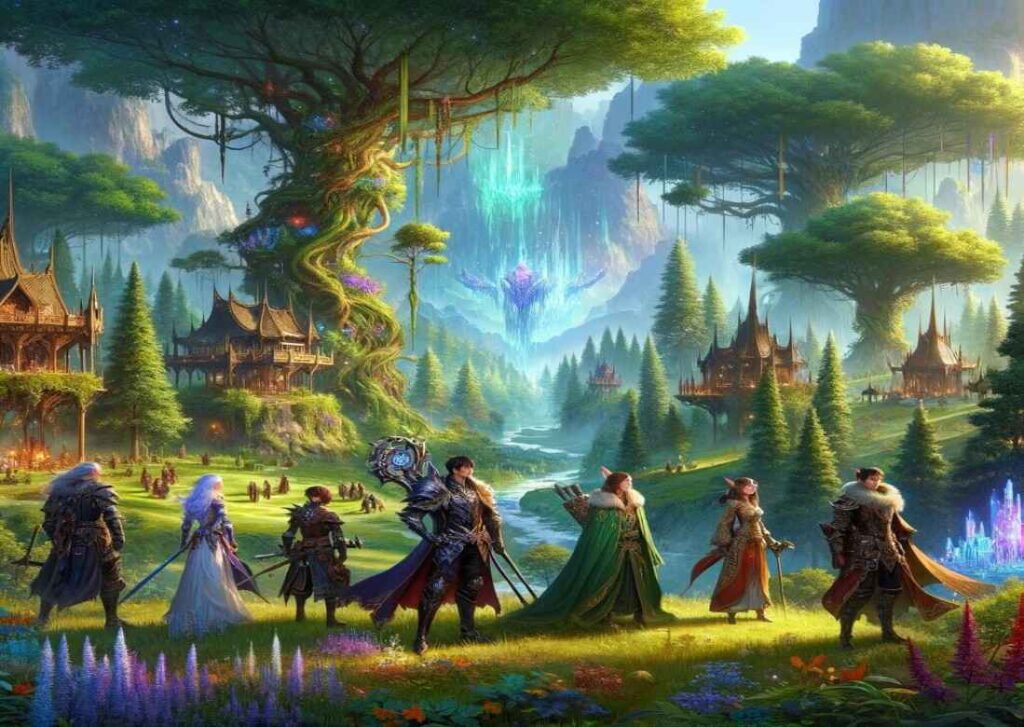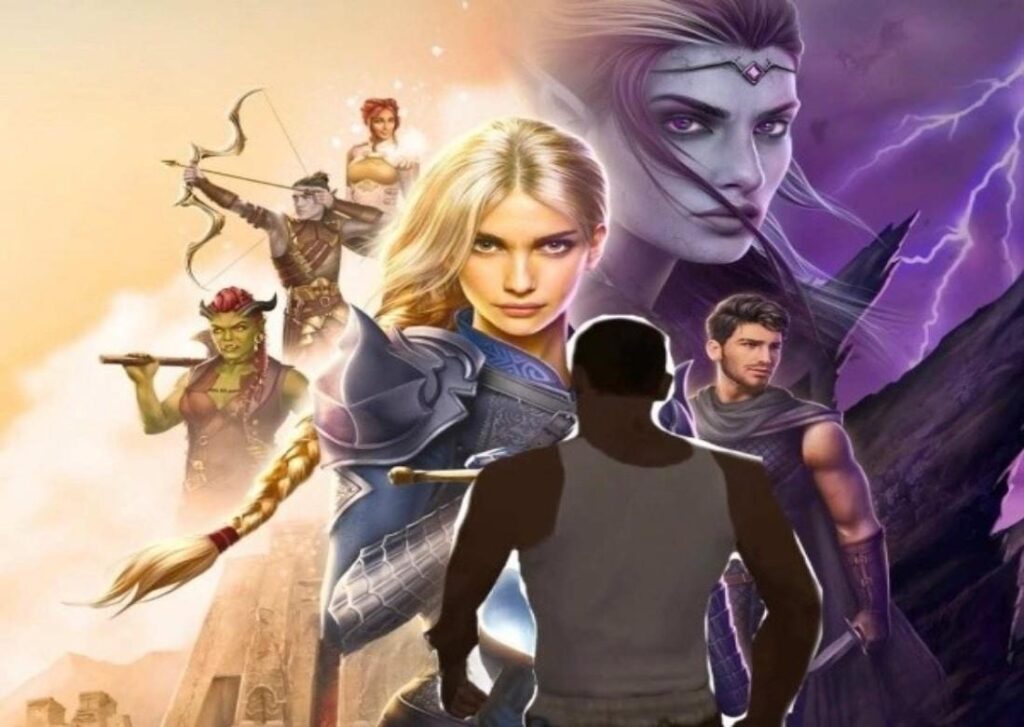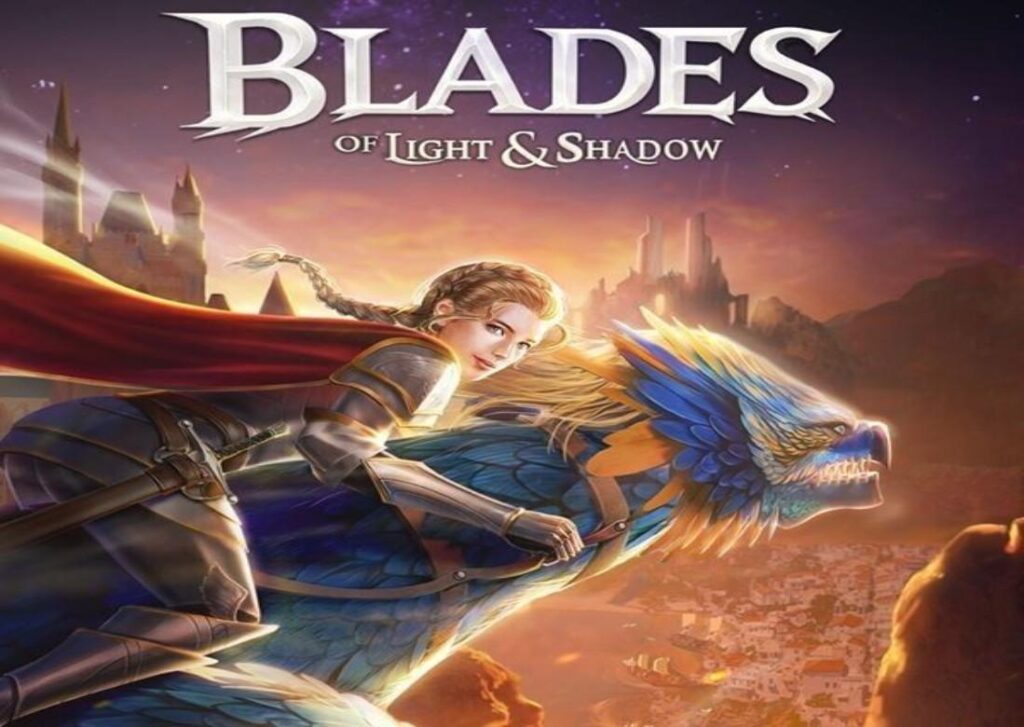Exploring the Fantasy Realm: A Deeper Look into Blades of Light and Shadow Book 2
Dive into the intricate world of Blades of Light and Shadow Book 2. Here, fantasy meets interactive storytelling. This follow-up to the beloved first installment continues to captivate readers. It presents a unique blend of adventure, romance, and mystery. As players navigate through its rich narrative, they encounter complex characters. Each decision influences the unfolding plot. Moreover, the game enriches player engagement with beautifully crafted environments. Additionally, unexpected twists keep the adventure both thrilling and unpredictable. Thus, Blades of Light and Shadow Book 2 secures its place as a standout title in interactive media.
Overview of Blades of Light and Shadow Book 2:
Storyline and Setting:
Blades of Light and Shadow Book 2 picks up where the thrilling first installment left off. In this sequel, the journey deepens, expanding the universe players have grown to love. Set in a richly detailed world, the game blends mythical themes with a vibrant tapestry of cultures. The setting traverses from bustling cities to mysterious, shadowed forests. Each location is crafted with precision, enhancing the story’s immersive feel.
The central narrative continues to follow the protagonist’s quest. They are determined to thwart a looming dark threat. This enemy, introduced in the first book, gains complexity and motive. Here, layers of their past are unveiled, adding depth to their character. The protagonist, too, faces personal growth. Their decisions carry greater weight, affecting their path and relationships.
Blades of Light and Shadow Book 2 expertly uses its setting to mirror the internal conflicts of its characters. For instance, the bright, expansive capitals contrast with the dim, confining spaces where darker plots unfold. This use of environment enriches the storytelling, making the player’s choices feel significant and impactful.
Intricate Character Dynamics and Strategic Conflicts
New allies join the journey, each bringing unique skills and perspectives. These characters are not mere additions; they are integral to the storyline. Their backgrounds and ambitions tie closely with the game’s broader themes of trust and betrayal. Interactions with these characters can lead to alliances or rivalries, depending on the player’s choices.
Moreover, the game introduces new enemies that challenge the players both intellectually and physically. These antagonists are not straightforward villains. Instead, they have compelling motivations and believable backstories. This complexity makes the conflicts within Blades of Light and Shadow Book 2 more engaging and difficult to navigate.
Romantic subplots also evolve in this sequel. Relationships that were budding in the first book can blossom or falter. The emotional depth here is palpable, making each romantic choice deeply consequential. This element of choice is a hallmark of the series, and it shines brightly in this installment.
Lore Expansion and Climactic Conclusions
The sequel not only enhances personal stakes but also expands on the lore of the world. Ancient histories are explored, revealing secrets that reshape understandings of the present conflicts. These revelations are paced perfectly, maintaining suspense and engagement throughout the game.
Puzzles and challenges in Blades of Light and Shadow Book 2 are intricately tied to the storyline. Solving them often requires understanding character motivations and using environmental clues. This integration ensures that the gameplay remains compelling and that the narrative propels the action.
The game also addresses themes of power and responsibility. As the protagonist’s abilities grow, so does the complexity of their choices. The consequences of their decisions ripple through the world, affecting not just their companions but entire kingdoms.
Blades of Light and Shadow Book 2 culminates in a climax that is both climactic and deeply personal. The final confrontations are not only about physical battles but also ideological conflicts. These are framed through earlier choices, giving a satisfying sense of culmination to the player’s journey.
In conclusion, Blades of Light and Shadow Book 2 is a masterclass in interactive storytelling. It weaves complex characters, a compelling plot, and rich settings into a tapestry that players can influence through their choices. The game’s world is a character in itself, full of mystery and intrigue that invites players to dive deep and explore every corner. As such, this sequel not only meets but exceeds the expectations set by its predecessor, marking it as a must-play for fans of the genre.
Main Characters and Development:
In Blades of Light and Shadow Book 2, the narrative depth is enhanced significantly through the evolution of its main characters. Each character not only continues their journey from the first installment but also undergoes substantial personal growth, facing new challenges and making tough decisions that redefine their paths.
The protagonist, whose character arc is largely shaped by player choices, stands at the forefront of this development. Initially driven by a straightforward motive—be it revenge, justice, or exploration—their objectives become increasingly complex. Throughout this sequel, they grapple with leadership responsibilities and the moral dilemmas these roles entail. This growth is not linear; it’s shaped by successes and failures, making the protagonist’s journey relatable and dynamically rich.
New Dynamics and Deepened Roles
Alongside the protagonist, a cast of returning companions each have their arcs expanded. For example, the fierce warrior who struggled with loyalty versus personal desires in Book 1 now finds those conflicts intensified. As they venture through new lands and encounter fresh adversaries, the warrior’s beliefs and relationships are tested, prompting significant character development and revealing deeper layers of their personality.
A new addition to the team is a mysterious figure with ambiguous loyalties. Introduced early in Blades of Light and Shadow Book 2, this character brings a fresh dynamic to the group. Their expertise in areas unknown to other team members makes them indispensable, yet their secretive nature adds a layer of tension. Players must decide how much they trust this enigmatic ally, influencing not only the group’s strategy but also interpersonal relationships within the team.
The sage, a wise and kind-hearted mentor from the first book, continues to offer guidance but also faces their own challenges. In this sequel, the sage’s past decisions come to light, revealing complications that test their wisdom and ethical standings. This development adds a poignant layer to their interactions with the protagonist, as they now learn from each other, demonstrating that even mentors have room to grow.
Antagonist’s Complexity and Secondary Characters
The antagonist’s role is also significantly deepened in Book 2. If they were merely a shadowy threat before, now their motivations, backstory, and ultimate goals are explored, providing a clearer picture of what drives them. This exploration makes the conflict more personal and complex, as players understand that the antagonist is not just a simple foil to the protagonist but a character with their own painful truths and ambitions.
Romantic interests also evolve in nuanced ways. Relationships that were budding in the first book can now deepen, face challenges, or take surprising turns based on the player’s choices. These developments are thoughtfully woven into the main narrative, ensuring that romantic subplots enhance rather than detract from the overarching story.
Moreover, each character’s development is reflected in their abilities and roles within the team. As the characters grow, new skills are unlocked, and existing ones are enhanced, affecting the gameplay directly. This progression reinforces the idea that the characters are evolving, not just in narrative terms but in practical, gameplay-focused ways as well.
The sequel also introduces a variety of secondary characters who enrich the world. These characters bring their own stories, adding depth to the main narrative and providing new insights into the world of Blades of Light and Shadow Book 2. Some of these figures are allies, while others are adversaries, but all are crafted with attention to detail that makes the game’s world feel alive and populated with real, believable characters.
In conclusion, Blades of Light and Shadow Book 2 excels in character development, transforming its cast from mere fictional creations into complex individuals with motives, desires, and dilemmas that resonate with players. This deep, character-driven narrative makes every decision impactful and every interaction meaningful, enhancing the immersive experience that fans cherished in the first book and elevating it to new heights in the sequel.

This image created for Blades of Light and Shadow Book 2, depicting a fantasy video game scene. This visual captures the lush, expansive kingdom and a group of diverse characters, including a skilled mage, an honorable mercenary, and an Elven diplomat, set against a backdrop of intricate tree-top dwellings and a mystical, shimmering cave.
Key Features of the Gameplay:
Choice-Based Mechanics for Blades of Light and Shadow Book 2:
In Blades of Light and Shadow Book 2, the cornerstone of gameplay revolves around the intricate choice-based mechanics that have been finely tuned to offer a uniquely personalized experience. This approach ensures that every decision made by the player has a tangible impact on the unfolding narrative, molding the story’s direction, relationships, and even the protagonist’s personal development.
The gameplay is built on a foundation where choices are not merely cosmetic. They actively shape the course of events, leading to multiple endings and varied paths through the game. This dynamic structure is crucial in enhancing replay value, as players are often tempted to explore different choices to see all possible outcomes.
From the onset of the game, players are presented with choices that range from simple dialogue options to major decision points. These choices influence how other characters perceive and interact with the protagonist. For example, choosing to spare an enemy could earn a character’s respect or distrust, affecting future alliances and available support in critical missions.
Moreover, the player’s choices extend to strategic planning and battle tactics. Decisions about which characters to bring on missions, how to approach conflicts, and when to use special abilities can drastically alter the outcome of battles and key events. These decisions ensure that gameplay remains engaging and that players feel directly responsible for their successes or failures.
Impact of Choices on Relationships and Moral Dilemmas
The influence of choice extends into the game’s romantic subplots, where the player’s interactions can deepen or strain relationships with potential love interests. These relationships are crafted with depth, and choices made in these areas can lead to poignant moments, betrayals, or lasting partnerships that influence the broader storyline.
Blades of Light and Shadow Book 2 also incorporates moral dilemmas that challenge the player’s ethics and objectives. The choices here are not clear-cut and often involve significant trade-offs. Players must weigh the immediate benefits against long-term consequences, which adds a layer of complexity to the decision-making process.
Consequences and Thematic Exploration
Feedback mechanisms are integrated throughout the game to reflect the consequences of the player’s choices. These feedback loops are evident through character dialogues, changes in the environment, and shifts in narrative tone. The game adeptly shows how the world reacts to the player’s actions, reinforcing the impact of their decisions.
To enhance the sense of agency, Blades of Light and Shadow Book 2 includes several key moments where the choices are particularly consequential, dramatically altering the story’s trajectory. These pivotal decisions can lead to the discovery of secrets, unexpected alliances, or the untimely demise of key characters.
The game also cleverly uses its choice-based mechanics to explore themes such as leadership, sacrifice, and power. Players are often put in positions where they must decide who to trust and how to lead their group. These decisions resonate with the game’s thematic concerns, making the gameplay experience both entertaining and thought-provoking.
In terms of technical execution, Blades of Light and Shadow Book 2 uses a sophisticated algorithm to track decisions and their ramifications. This tracking ensures that the narrative remains coherent and that the accumulated effects of the player’s choices are reflected accurately in the game’s climax and resolution.
In conclusion, the choice-based mechanics in Blades of Light and Shadow Book 2 are a defining feature of the gameplay, offering a rich tapestry of cause and effect that ensures each playthrough is unique. This level of interactivity allows players to deeply engage with the narrative and characters, crafting a personalized story that is both memorable and impactful.
Artwork and Visuals:
In Blades of Light and Shadow Book 2, the visual enhancements and artwork styles are not merely decorative. They significantly enrich the gaming experience, drawing players deeper into the story’s immersive world. This sequel has taken the graphical elements to new heights, showcasing a noticeable evolution from its predecessor.
At the outset, the artwork of Blades of Light and Shadow Book 2 captivates with its richer, more detailed environments. Each setting is rendered with an eye for texture and lighting, creating atmospheres that are both striking and mood-enhancing. For instance, the shadowed forests are depicted with deep, dark hues and subtle movements in the underbrush, suggesting the lurking dangers, while the bustling cities glow with vibrant colors and dynamic light sources that reflect the hustle and bustle of urban life.
Character Design and Animation Improvements
Character designs have also received significant attention in this installment. The characters feature a range of expressions and more intricate costumes that reflect their personalities and growth throughout the series. This attention to detail in character design adds depth to the narrative, as players can see and feel the changes in characters’ statuses and moods, enhancing the emotional engagement of the story.
The visual style of the game employs a unique blend of traditional fantasy with elements of mystical realism. This stylistic choice sets Blades of Light and Shadow Book 2 apart from other games in the genre, giving it a distinctive look that captivates players. The use of color palettes is particularly effective; warm tones are used in scenes of camaraderie and safety, while cooler tones prevail in moments of uncertainty and danger, subtly influencing the player’s emotional response.
Moreover, the animation quality in Blades of Light and Shadow Book 2 has seen improvements, with smoother transitions and more fluid motion sequences. Combat scenes are especially enhanced, with animations that convey the weight and impact of each blow, making the battles more thrilling and realistic. This level of detail not only improves the visual appeal but also helps in making the gameplay more intuitive.
Artistic Integration and Cinematic Quality
The artistic integration extends beyond characters and environments. The user interface and visual effects used for magic and special abilities are designed to be both visually stunning and informative. Spells cast by characters have distinct visual signatures that reflect their nature and intensity, helping players quickly identify the effects and strategies during gameplay.
Interactive elements within the game are also meticulously designed. Puzzles and artifacts that players interact with are not only functional but are imbued with artistic qualities that make them blend seamlessly into the world. This integration ensures that gameplay mechanics do not disrupt the visual storytelling but rather enhance it.
The artistic team behind Blades of Light and Shadow Book 2 has collaborated closely with the narrative developers to ensure that the visuals accurately reflect the story’s themes and moods. This collaboration is evident in the way visual cues are used to foreshadow events or highlight narrative elements, adding layers of meaning to the player’s experience.
In addition to the static artwork, the cinematic cutscenes are a highlight, providing breathtaking visual narratives that bridge key plot developments. These cutscenes are crafted with cinematic quality, employing techniques such as panning, zooming, and focus shifts to emphasize emotional and critical moments in the story.
In conclusion, the artwork and visuals in Blades of Light and Shadow Book 2 are not only a feast for the eyes but also an integral part of the storytelling. The game’s visual enhancements and artwork styles play a crucial role in conveying the depth of the narrative and the complexity of its world, making each moment in the game both a visual and an emotional experience. This commitment to visual excellence ensures that Blades of Light and Shadow Book 2 remains memorable and engaging, setting a new standard for what players can expect from interactive storytelling in the gaming world.
What’s New in Blades of Light and Shadow Book 2:

New Characters and Allies:
Blades of Light and Shadow Book 2 introduces a host of new characters, each bringing unique dynamics to the evolving storyline. These additions are not only crucial to the plot but also enrich the world-building, providing fresh perspectives and deeper insights into the game’s lore.
One of the most intriguing new characters is Aeliana, a skilled mage from the secretive Order of the Arcane. Her expertise in ancient magic and arcane lore quickly becomes indispensable to the protagonist’s quest. Aeliana’s mysterious past and her connection to the arcane energies are gradually revealed, adding layers of intrigue and tension to the narrative.
Next, we meet Jorath, a mercenary with a code of honor that sets him apart from his brethren. His introduction brings a gritty, realistic edge to the group dynamics. Jorath’s expertise in guerrilla warfare and his pragmatic approach to problem-solving prove vital in several key missions. His complex relationship with authority and his quest for redemption challenge the other characters’ views on justice and morality.
Another significant addition is Elowen, a diplomat from the Elven courts. Her diplomatic skills open new pathways for the group, allowing them to navigate complex political landscapes without resorting to violence. Elowen’s presence introduces elements of elven culture, politics, and their long-standing tensions with human kingdoms, enriching the game’s historical context.
Strategic Additions to the Gameplay
The character of Torbin, a beastmaster who communicates with creatures of all kinds, adds a unique element to the gameplay and story. His ability to understand and influence creatures provides a strategic advantage in various scenarios. Torbin’s deep respect for nature and his philosophical insights into the balance of the ecosystems bring a new dimension to the team’s adventures.
Blades of Light and Shadow Book 2 also features the enigmatic villainess, Seraphine. While initially an adversary, the depth of her character unfolds through intricate backstories, revealing her motivations and the tragic events that led her down the path of darkness. Seraphine’s character challenges the players’ perceptions of good and evil, making her one of the most complex figures in the storyline.
Dynamic Group Chemistry and Story Integration
The introduction of these characters significantly enhances the interactive experience by providing varied paths and choices. Each character introduces new quests, challenges, and story arcs that are deeply integrated into the main plot. Their interactions with the established characters test old alliances and forge new ones, dynamically altering the group’s chemistry.
Moreover, these characters bring with them new abilities and skills that add to the gameplay mechanics. For example, Aeliana’s mastery of the arcane can unlock previously inaccessible areas or secrets, while Jorath’s tactical acumen can change the outcome of battles.
Thematic Depth and Character Development
The roles of these new characters are carefully crafted to ensure that they contribute meaningfully to the narrative. They are not merely additions but are central to the unfolding of key plot points. Their decisions and development are intertwined with the player’s choices, emphasizing the game’s core mechanics of choice and consequence.
In addition to their functional roles within the game, these characters enhance the thematic depth of Blades of Light and Shadow Book 2. They embody themes such as redemption, the nature of power, and the complexities of political intrigue. As players interact with these characters, they are invited to explore these themes in depth, leading to a richer, more engaging gameplay experience.
In conclusion, the new characters in Blades of Light and Shadow Book 2 play pivotal roles in both the narrative and gameplay. They bring fresh perspectives, enhance the world-building, and deepen the interactive storytelling that fans cherished in the first book. Each character is meticulously developed, with their own arcs and contributions to the game’s central themes, making their introduction a key highlight of this sequel.
Expanded Worlds and Environments:
Blades of Light and Shadow Book 2 significantly broadens the scope of its world, introducing players to a variety of new settings that enrich the gaming experience. These expanded worlds and environments are not just visually stunning but are also integral to the progression of the storyline and the development of the characters.
One of the most notable new environments is the Verdant Kingdom, a lush, expansive region dominated by dense forests and sprawling meadows. This kingdom is a stark contrast to the arid landscapes of Book 1, offering players a refreshing change of scenery. The Verdant Kingdom is home to the Woodland Elves, a new race introduced in this sequel. Their intricate tree-top dwellings and complex societal structures offer new dynamics and political intrigues to explore.
Another intriguing environment is the Crystalline Caves, located in the northern reaches of the map. These caves are not only a spectacle of natural beauty, with their shimmering crystal formations and eerie light reflections, but they also hold dark secrets tied to the ancient magic of the world. The caves are a labyrinth of tunnels and chambers that challenge players with puzzles and traps, testing their problem-solving skills and agility.
Innovative and Immersive Urban Settings
The game also introduces the Sunken City, submerged beneath the sea’s surface, accessible only through magical means or intricate technology. This environment introduces an underwater aspect to the gameplay, adding new challenges and aesthetics. The Sunken City is hauntingly beautiful, with its coral-adorned ruins and mysterious, luminescent creatures. It holds remnants of a long-lost civilization, offering rich lore for players to uncover.
Mystical and Underwater Exploration
In addition to natural and mystical environments, Blades of Light and Shadow Book 2 expands into more urban settings. The City of Gears, a metropolis powered by steam and sorcery, is a hub of innovation and conflict. The city’s intricate machinery and steam-powered contraptions offer a stark contrast to the magical elements of the game, showcasing the clash between magic and technology. The bustling streets, marketplaces, and shadowy alleys of the City of Gears are alive with merchants, inventors, and spies, providing a myriad of quests and subplots.
The expansion of worlds in Blades of Light and Shadow Book 2 also includes the ethereal Realm of Echoes, a dimension that exists parallel to the physical world. This realm is a place of spirits and memories, where players can interact with echoes of the past and uncover hidden truths about the main characters and the world’s history. The Realm of Echoes is visually distinct, with a surreal, dream-like quality that makes it one of the most memorable settings in the game.
Interconnected Story and Environmental Integration
Each new environment is meticulously crafted, with attention to detail that immerses players in the world. The different settings are not only visually distinct but also feature unique challenges, creatures, and cultures, enhancing the game’s diversity and complexity. The environmental hazards, from treacherous terrain to hostile creatures, require players to adapt their strategies, making exploration both challenging and rewarding.
Moreover, the environments interact with the story in meaningful ways. The history and conflicts of each new area are deeply intertwined with the main narrative arcs. Characters from these regions have their own stories, which weave into the larger plot, making the world feel interconnected and alive.
In conclusion, the expanded worlds and environments in Blades of Light and Shadow Book 2 are a testament to the game developers’ commitment to creating a rich, immersive experience. These settings do more than serve as backdrops; they are active elements of the story that engage players, challenge their skills, and enhance the overall narrative. The introduction of these new worlds significantly enriches the gameplay, making every exploration a discovery and every challenge a stepping stone in the unfolding epic.
Critical Reception and Reviews of Blades of Light and Shadow Book 2:

Critic Reviews:
Blades of Light and Shadow Book 2 has been met with enthusiastic acclaim from critics across the gaming and interactive storytelling communities. This sequel not only builds on the solid foundation laid by its predecessor but also expands its horizons, deepening both the narrative and gameplay elements. Critics have highlighted several key points that contribute to the game’s success, echoing the sentiments of a growing fan base.
One of the most praised aspects of Blades of Light and Shadow Book 2 is its rich, complex storyline. Critics have noted that the game’s plot is not only engaging but also filled with unexpected twists and turns that keep players on the edge of their seats. The narrative’s depth is enhanced by the introduction of new characters and the expansion of the game’s world, which together create a more immersive experience. The story’s ability to weave together multiple character arcs and thematic elements into a cohesive whole has been a particular point of commendation.
Innovative Gameplay and Decision-Making Mechanics
Another significant highlight from the reviews is the enhanced choice-based mechanics. Critics have applauded the game for its sophisticated decision-making system, which allows players to truly influence the outcome of the story. Each choice is impactful, with long-reaching consequences that can alter the narrative in significant ways. This level of interactivity has been praised for adding replay value, as players are encouraged to explore different pathways and outcomes.
Visual Artistry and Character Development
The artwork and visuals of Blades of Light and Shadow Book 2 have also received considerable attention. Reviewers have remarked on the visual upgrades from the first installment, emphasizing the detailed environments and character animations that make the game a visual feast. The artistic style, which blends fantastical elements with a touch of realism, has been noted for its ability to transport players directly into the game’s world, enhancing the overall immersive experience.
Critics have also focused on the game’s character development. The way Blades of Light and Shadow Book 2 handles character arcs and their evolution throughout the game has been widely praised. The new characters are well-integrated into the storyline, each adding a new layer of intrigue and complexity. The development of these characters, according to reviews, is one of the sequel’s strongest points, contributing greatly to the narrative depth and emotional engagement of the game.
Environmental Diversity and Technical Sound Design
The introduction of new worlds and environments in Blades of Light and Shadow Book 2 has been another focal point for positive critical reception. Reviewers have admired the creativity and thought put into each new setting, noting that the environments are not only beautifully rendered but also play a crucial role in the storyline. The diversity of settings challenges players to adapt their strategies and approaches, which enriches the gameplay experience.
Furthermore, the sound design and musical score of the game have been highlighted as elements that significantly enhance the atmospheric quality of Blades of Light and Shadow Book 2. The audio is carefully crafted to match the visuals and actions, adding a layer of depth that has been appreciated by both critics and players alike.
Despite its many strengths, some critics have offered constructive criticism, particularly regarding the pacing of the story in some sections of the game. A few reviews pointed out that while the plot is generally engaging, there are moments where the pacing could be tightened to maintain a more consistent level of engagement.
In conclusion, Blades of Light and Shadow Book 2 has been received positively by the critic community, who commend its storytelling, visual artistry, character development, and gameplay mechanics. The game has been described as a benchmark for interactive storytelling, with its ability to blend narrative depth, aesthetic beauty, and player agency into a compelling and engaging experience.
Player Feedback:
Blades of Light and Shadow Book 2 has been met with a passionate response from its player base, whose feedback has been instrumental in gauging the game’s success and areas for improvement. The interaction between the game creators and the community has been a key element in the ongoing development and refinement of the game experience.
Enthusiastic Approvals
Many players have praised Blades of Light and Shadow Book 2 for its enhanced storytelling and depth of narrative. Fans of the series have expressed appreciation for the way new characters and plots weave seamlessly with the storylines established in the first book. The introduction of new environments and the expansion of the game’s world have been particularly well-received, with players enjoying the exploration of diverse settings that are both visually stunning and rich in lore.
The choice-driven gameplay continues to be a highlight for many. Players have noted that the decisions they make feel genuinely impactful, shaping the story in significant and sometimes unexpected ways. This level of agency has been celebrated for making each playthrough unique, providing a personalized experience that encourages multiple replays to explore different narrative paths.
Visual and Artistic Praise
On the visual front, the artwork and design improvements in Blades of Light and Shadow Book 2 have drawn considerable acclaim. Players have commented on the exquisite detail in character designs and settings, noting that the game’s aesthetics greatly enhance the immersive experience. The visual effects used for magic and combat sequences have been highlighted as particularly impressive, adding excitement and a dynamic feel to engagements.
Audio Enhancements
The enhanced sound design and musical scores have also been a point of positive feedback. Players have appreciated the atmospheric music and sound effects, which complement the action and drama of the story. The audio enhancements contribute to the overall emotional and immersive quality of the game, making the experiences within more compelling.
Constructive Critiques
Despite the strong positive feedback, some players have offered constructive criticism, particularly regarding certain gameplay mechanics and pacing. A few players have mentioned that some sections of the game feel slower compared to others, suggesting a more balanced pacing could enhance the overall gameplay rhythm.
Moreover, while the complex storylines are generally seen as a strength, some players have found certain plot twists and character arcs to be less well-developed or too predictable. These critiques often come with suggestions for deeper character development and more surprising, innovative plot developments in future installments.
Technical Aspects
On the technical side, a few players have encountered bugs that affect gameplay. These issues are typically related to game updates and new content releases. The responsiveness of the development team in addressing these bugs has been generally praised, though some players express a desire for quicker fixes to enhance continuity and enjoyment.
Community and Social Interaction
The community aspect of Blades of Light and Shadow Book 2 has been another significant point of discussion. Players enjoy the community features, such as forums and multiplayer aspects, which allow them to discuss strategies, share experiences, and even collaborate within the game. This social interaction has fostered a dedicated fan base and created a lively, engaging community atmosphere.
In Conclusion
Overall, Blades of Light and Shadow Book 2 has enjoyed a favorable reception from its players, who cherish the game for its storytelling, visual and audio presentations, and interactive gameplay. The feedback from players not only celebrates the game’s achievements but also provides constructive insights that could help refine future chapters of the game. As the series progresses, this feedback will be invaluable in shaping its development, ensuring that “Blades of Light and Shadow” continues to evolve and captivate its audience.
Comparisons to Other Interactive Books:

Similarities to Other Titles:
Blades of Light and Shadow Book 2 stands as a monumental achievement in the genre of interactive books, reflecting a sophisticated blend of narrative depth, character development, and player engagement. When comparing it to other titles in this space, several similarities emerge, particularly in gameplay mechanics and story elements, which highlight the game’s standing within the industry.
Narrative Complexity and Branching Choices
Like many popular interactive books such as “Choice of Games” titles and “Telltale’s The Walking Dead,” Blades of Light and Shadow Book 2 offers a deeply branching narrative. This approach allows players to make choices that significantly impact the storyline. Each decision can lead to vastly different outcomes, ensuring that no two playthroughs are exactly the same. This level of narrative complexity is a hallmark of modern interactive storytelling, emphasizing player agency and making the narrative feel personal and dynamic.
Character-Driven Stories
Character development is another area where Blades of Light and Shadow Book 2 shows strong similarities to other leading titles in the interactive book genre, such as “Life is Strange” and “The Wolf Among Us.” The game focuses heavily on character arcs and relationships, allowing players to not only influence the plot but also the interpersonal dynamics between characters. This creates a rich tapestry of interactions that can lead to friendships, rivalries, or romances, all of which add layers to the narrative and make the world feel alive and reactive.
Graphical and Artistic Presentation
Visually, Blades of Light and Shadow Book 2 compares favorably with other narrative-driven games like “Dream fall Chapters” and “Heavy Rain,” which also utilize a strong visual style to enhance storytelling. The detailed environments, expressive character models, and atmospheric effects in Blades of Light and Shadow Book 2 help immerse players in the game’s world, much as the aforementioned titles use their visuals to draw players into their respective narratives. The use of visuals to convey mood and theme is particularly effective in interactive books, where visual cues can provide context and emotional depth.
Integration of Puzzles and Challenges
Interactive books often integrate puzzles and challenges to add layers of engagement, and “Blades of Light and Shadow Book 2” is no exception. Similar to games like “80 Days” or “Sorcery!,” this title incorporates strategic elements and problem-solving into its gameplay. These challenges are seamlessly woven into the story, requiring players to think critically about their choices and strategies. The integration of these elements ensures that the gameplay remains engaging and that players are actively participating in the unfolding of the narrative.
Ethical Dilemmas and Moral Choices
A defining feature of many interactive books is the incorporation of ethical dilemmas and moral choices, as seen in “Detroit: Become Human” and “Until Dawn.” Blades of Light and Shadow Book 2 similarly challenges players with decisions that have no clear right or wrong answers but instead focus on shades of gray. These choices often have significant consequences for the characters and the world, adding a weighty, philosophical element to the gameplay that encourages players to reflect on their values and the potential impacts of their actions.
Cultural and World Building
In terms of world-building, Blades of Light and Shadow Book 2 shares similarities with expansive RPGs like “The Elder Scrolls” series, where detailed lore and cultural depth are key components. The game’s world is rich with history, mythology, and diversity, offering players a broad canvas to explore. This attention to cultural detail not only enhances the immersion but also provides a backdrop against which complex narratives can unfold.
In comparison to other interactive books, Blades of Light and Shadow Book 2 holds its own with its intricate plot, deep character interactions, stunning visuals, and thoughtful integration of puzzles. The game’s ability to blend these elements together showcases its excellence in interactive storytelling, making it a benchmark for others in the genre. As interactive books continue to evolve, Blades of Light and Shadow Book 2 remains a standout title that offers a compelling, immersive, and thought-provoking experience.
Unique Elements in Blades of Light and Shadow Book 2:
Blades of Light and Shadow Book 2 distinguishes itself in the crowded field of interactive storytelling through several unique elements that set it apart from similar titles. These distinctive features contribute not only to the game’s individuality but also to its success and popularity among fans of the genre.
Innovative Use of Non-Linear Storytelling
One of the most distinctive aspects of Blades of Light and Shadow Book 2 is its sophisticated approach to non-linear storytelling. Unlike many interactive books that offer branching paths, this game integrates multiple storylines that intersect and diverge in complex ways depending on player choices. This method allows for a more dynamic narrative structure, where decisions from seemingly unrelated events can impact one another, creating a web of consequences that is both unpredictable and engaging.
Deep Integration of Character Backstories
Another standout feature is the deep integration of characters’ backstories into the main plot. Each character is developed with a rich history that players can explore through various subplots. These backstories are not just additional information; they are crucial to understanding motivations and relationships within the game. This level of character depth enhances emotional investment and adds layers of complexity to the story, making each interaction and decision feel impactful.
Environmental Interactivity
Blades of Light and Shadow Book 2 also excels in environmental interactivity. The game’s world is not merely a backdrop for the narrative; it’s an active element that players can interact with and influence. From altering landscapes to accessing hidden areas based on player actions, the environment responds and changes, reflecting the game’s dynamic world. This responsiveness not only increases immersion but also adds a layer of strategy to the gameplay, as players must consider their surroundings as an active participant in the story.
Combination of Genres
The game uniquely blends elements from multiple genres, including fantasy, mystery, and romance, creating a rich and diverse narrative experience. This blend allows the game to appeal to a broad audience and keeps the gameplay fresh and engaging. By incorporating different genre elements, Blades of Light and Shadow Book 2 ensures that no part of the game feels monotonous or predictable.
Dynamic Character Relationships
The dynamics of character relationships in Blades of Light and Shadow Book 2 are more complex than in typical interactive books. Relationships evolve based on player choices, with possibilities for alliances, betrayals, friendships, and romances that can all shift over the course of the game. These relationships are not static; they require careful management and can have significant implications for the story’s outcome.
Real-Time Decision Making
A unique gameplay element is the incorporation of real-time decision making. Unlike other games where players can take their time to make choices, Blades of Light and Shadow Book 2 sometimes requires decisions to be made quickly, simulating real-life pressures. This feature adds an exciting, realistic element to gameplay, enhancing the stakes during critical moments.
Artistic and Audio Mastery
The visual and audio design of Blades of Light and Shadow Book 2 stands out through its artistic mastery. The game features hand-drawn illustrations that bring scenes to life with exceptional detail and vibrancy. Coupled with a meticulously crafted soundtrack that adapts to the storytelling, the game offers a sensory experience that deeply enhances the emotional and atmospheric elements of the game.
Interactive Learning Elements
Interestingly, the game incorporates interactive learning elements that allow players to gain insights into the game’s lore and mechanics without breaking immersion. These elements are woven into the narrative and can be accessed as part of the gameplay, providing educational content about the world and its inhabitants in a way that feels natural and engaging.
Ethical Complexity
Lastly, Blades of Light and Shadow Book 2 is notable for its ethical complexity. The game challenges players with moral dilemmas that have no clear right or wrong answers but instead focus on the consequences of actions. This ethical depth encourages players to think critically about their choices and consider broader implications beyond immediate outcomes.
In conclusion, Blades of Light and Shadow Book 2 is not just another entry in the genre of interactive books; it is a standout title that pushes the boundaries of narrative and interactive design. Its unique features ensure a captivating, immersive, and thought-provoking experience that resonates with players long after they finish the game.

Some FAQs about Blades of Light and Shadow Book 2:
1. What is Blades of Light and Shadow Book 2?
It’s an interactive book that combines adventure, romance, and mystery, allowing players to shape the story through choices.
2. Can I play Blades of Light and Shadow Book 2 without playing the first book?
Yes, but playing the first book is recommended to fully understand the characters and storyline developments.
3. What platforms is Blades of Light and Shadow Book 2 available on?
The game is available on various platforms, including iOS, Android, and Windows.
4. How do choices affect the storyline in Blades of Light and Shadow Book 2?
Your choices directly influence character developments, plot outcomes, and even potential endings of the story.
5. Are there multiple endings in Blades of Light and Shadow Book 2?
Yes, the game features multiple endings based on the decisions you make throughout the gameplay.
6. Does Blades of Light and Shadow Book 2 have new characters?
Yes, the sequel introduces new characters, each adding depth and fresh challenges to the storyline.
7. Can I customize my character in Blades of Light and Shadow Book 2?
Yes, players can customize their character’s appearance and select attributes that affect their skills and relationships.
8. How long does it take to complete Blades of Light and Shadow Book 2?
The completion time can vary, typically ranging from 10 to 20 hours depending on your gameplay style.
9. Is there a multiplayer mode in Blades of Light and Shadow Book 2?
No, the game is primarily a single-player experience focused on personal decision-making and story progression.
10. Where can I find tips for playing Blades of Light and Shadow Book 2?
Tips and guides are available on gaming forums, the official website, and various walkthrough sites.
These FAQs provide a quick overview and helpful insights into Blades of Light and Shadow Book 2, assisting both new and returning players.
Conclusion: The Enthralling Journey of Blades of Light and Shadow Book 2
Blades of Light and Shadow Book 2 offers a deeply immersive and richly crafted experience that extends the captivating saga initiated in its predecessor. With its intricate narrative, detailed character development, and a visually stunning world, the game engages players on multiple levels, ensuring a truly interactive storytelling experience. As you make choices that significantly impact the storyline, the sense of agency and personal involvement in the unfolding drama is profound.
This sequel not only enriches the existing narrative but also introduces new characters and environments that add complexity and intrigue. The game’s enhanced choice-based mechanics allow for multiple endings, providing substantial replay value and encouraging players to explore all the different pathways their decisions could lead to.
Looking ahead, the potential continuation of the “Blades of Light and Shadow” series promises even more thrilling adventures and complex character interactions. Future installments will likely build upon the established foundation, expanding the world and delving deeper into its mysteries. Players can anticipate new challenges, enhanced interactive elements, and even richer storytelling in upcoming chapters.
Dive into Blades of Light and Shadow Book 2 now, and become part of a dynamic world that evolves with your choices, setting the stage for what is yet to come in this enthralling series.











Leave a Review